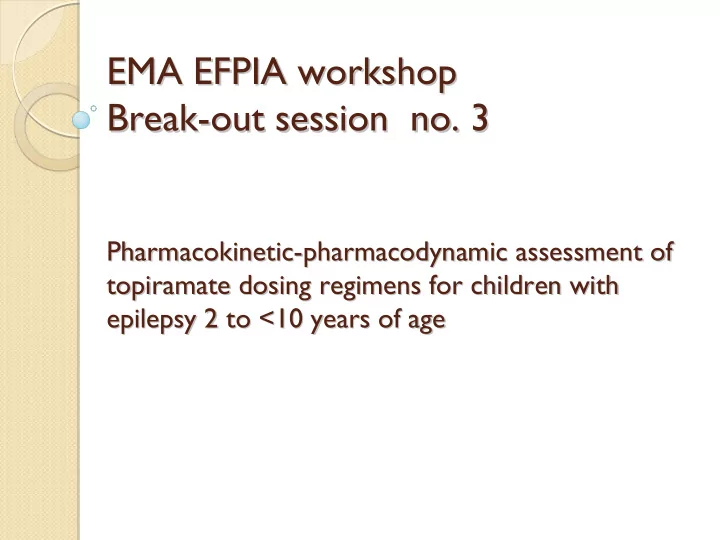

EMA EFPIA workshop EMA EFPIA workshop Break- -out session no. 3 out session no. 3 Break Pharmacokinetic- -pharmacodynamic assessment of pharmacodynamic assessment of Pharmacokinetic topiramate dosing regimens for children with topiramate dosing regimens for children with epilepsy 2 to <10 years of age epilepsy 2 to <10 years of age
MAIN ISSUES To bridge the data gap of limited or no information using M&S data integration evidence “synthesis”
Background & Rationale Background & Rationale Topiramate 2 yrs 6 yrs 10 yrs Adjunct therapy Approved Data Mono therapy Approved Data
Available Data 11 studies ◦ 8 adjunct: 2-68 years (12 patients < 6 years) ◦ 3 monotherapy: 6-85 years PK ◦ 1217 patients, 4640 observations PD Efficacy endpoint ◦ Adjunct therapy % reduction in seizure frequency Responder rate ◦ Monotherapy: time to first seizure
M&S Assumptions M&S Assumptions Pediatrics vs Adults Similar disease progression - Epilepsies in children: Similar response to topiramate - Partial onset seizures (POS) and Lennox-Gastaud syndrome - treatment effect can be extrapolated from adults to children Similar concentration-response relationship - Infantile epilepsies are specific to children: most relevant issue +++ - no possible extrapolation for treatment effect from adults to children - no possible extrapolation for PK/PD - epilepsy is often refractory and may even be worsened - no possible extrapolation for adverse events - possible model-based extrapolation for PK
Where are we? Where are we? No clinical No clinical No development development Will the Will the drug be used in drug be used in No a special population a special population ethnic group ethnic group or rare disease or rare disease Is the Is the Clinical efficacy Clinical efficacy indication the same Yes indication the same PK & safety data as in the current label? PK & safety data No as in the current label? Is the Is the Yes disease process disease process No similar to the current similar to the current indications? indications? PD PD Is the Is the PK & safety data PK & safety data Yes outcome of therapy outcome of therapy likely to be similar No likely to be similar (Efficacy /safety extrapolated (Efficacy /safety extrapolated In the new population In the new population from reference population) from reference population) Does efficacy Does efficacy Yes correspond with blood correspond with blood No levels in adult ? levels in adult ? Is the Is the dose-conc. dose-conc. Yes relationship likely to relationship likely to match that of match that of the current indication? the current indication? PK & safety data PK & safety data Yes (Efficacy/safety extrapolated (Efficacy/safety extrapolated from reference population) from reference population)
Factors Determining Treatment Factors Determining Treatment Response... Response... ADME Pharmacodynamics Disease Pharmacodynamics Disease (Progression) (Progression)
M&S Results (PK) M&S Results (PK) Two-compartment with 1 st –order absorption • Typical value Interindividual Parameter (%SE) variability (%SE) Clearance (L/h) CLSTM (baseline clearance 1.21 (1.2) 27.28 (10.2) monotherapy) ( θ 1 ) CLSTA (effect of adjuvant) ( θ 2 ) 0.479 (25.3) 0.453 (9.0) FCWT (effect of weight) ( θ 3 ) FCAGE (effect of age) ( θ 4 ) -0.00306 (30.9) FCIN (effect of INMD) ( θ 5 ) 1.94 (7.8) FCVP (effect of valproate) ( θ 6 ) 0.686 (7.8) 0.635 (6.2) FCNE (effect of NEMD) ( θ 7 ) Central volume of distribution (L) VST ( θ 8 ) 4.61 (33.2) 116.2 (35.0) FVWT (effect of weight) ( θ 9 ) 1.14 (19.1) Ka (h-1) ( θ 10 ) 0.105 (27.0) 22.34 (88.2) K23 (h-1) ( θ 11 ) 0.577 (16.7) NE K32 (h-1) ( θ 12 ) 0.0586 (23.6) NE CCV residual error (%CV) 25.46 (7.8) Additive residual error (mg/L) 0.1797 (39.9) %SE – percent standard error, NE, not evaluated.
M&S Results (PK/PD, adjunct M&S Results (PK/PD, adjunct- -therapy) therapy) % change in seizure frequency where, responder rate
M&S Results (PK/PD, monotherapy) M&S Results (PK/PD, monotherapy)
M&S Results (Dose M&S Results (Dose- -Response, monotherapy) Response, monotherapy)
Conclusions Conclusions - Absence of evidence of an effect of age is ONLY VALID for POS and Lennox- Gastaud syndrome - Otherwise MAJOR EFFECT OF AGE PK/PD data indicates no direct evidence of an effect of - other types of epilepsies … the most relevant to consider specifically age or pediatric status on the PD characteristics of - symptoms are different ( epilepsy syndromes) and are severe - refractory epilepsies topiramate when used alone or as adjunctive therapy - poor cognitive prognosis - need for a specific approach to infantile and juvenile epilepsies resistant The combination of PK/PD with PK modeling results has to usual first and second line anti-epileptic treatment: 2 step approach: permitted determination of steady-state C min values for - add-on observational approach: identification of candidate topiramate syndrome (s) monotherapy required to achieve seizure - add-on comparative trial vs placebo in the identified syndromes freedom in different age groups. - Avoid oversimplification in extrapolation for PK while ignoring the maturational differences in younger age-groups (below 2 years of age): Dosing regimen expected to achieve a 65–75% seizure model-based modelling approach rather than allometric approach freedom rate after 1 year for pediatric patients aged 2– 10 years is approximately 6–9 mg/kg per day. - FDA decision tree is not fully adequate in the most specific aspects of paediatric drug development due to oversimplification
Recommend
More recommend